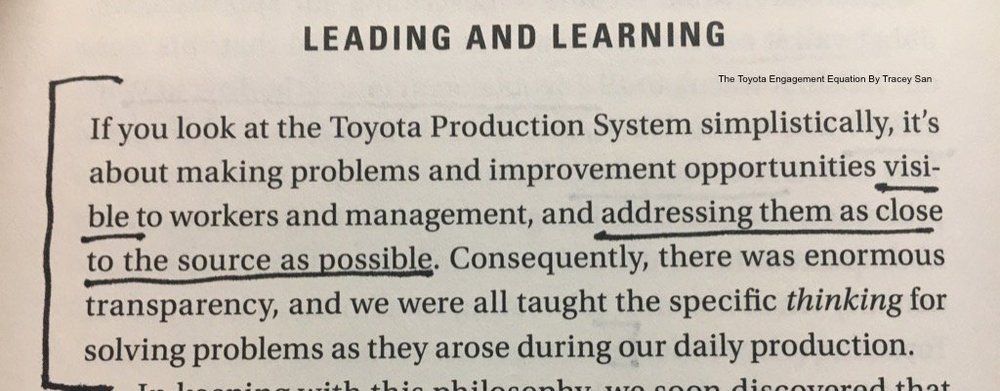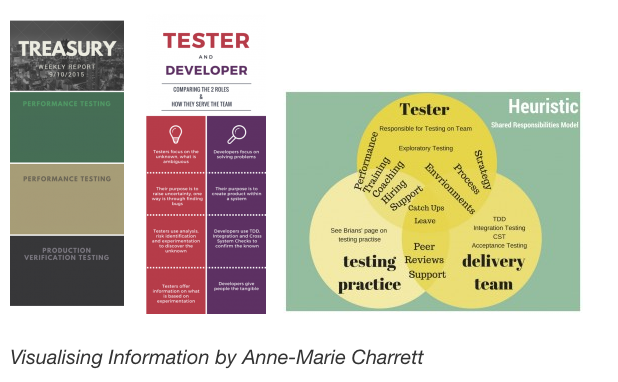Quality and the Toyota Production Model

I saw this tweet the other day prompting this post on quality, visualisation and quality at pace.
Don't worry @Tracey_san, I am not going to tweet the entire book. "The Toyota Engagement Equation." #lean pic.twitter.com/9jQBXBPMt6
— Mark Graban (@MarkGraban) August 3, 2017

Understanding Quality
“Quality is value to some person” is a Jerry Weinberg quote emphasising the subjective nature of quality. Tapping into an understanding of what your customers uphold, believe in and need goes a long way to creating a great product. It’s not easy to tap into what your customer’s value, but once you do, once you discover that “x-factor” you generate customer loyalty. Michael Bolton added “Quality is value to some person who matters”. I and others have added “at some point in time” to indicate the transient nature of quality. This is the beauty and terror of quality. Its notoriously difficult to understand, let alone measure and quantify. Often we resort to quality attributes in an attempt to know and measure it. How then does quality relate to the above tweet? What struck me was the underlined phrase: “Its about making problems….visible to workers and management, and addressing them as close to the source as possible” Breaking that down…
“Making problems visible….
Understanding and knowing what quality is for your team, your company and customers, makes it significantly easier to recognise problems that threaten its value. The difficulty is in knowing where these problems lie. If we knew where problems existed, their nature and size and their impact, making it visible would be much easier. Software testing helps us identify and shine a light on such problems. It gives us the knowledge we need to “know” if we are reaching the quality our stakeholders want. Poor old software testing though. Perceived as expensive and time consuming with every test having a cost. A cost in thinking about it, developing it, using it, evaluating the output, fixing any bugs related to running it, and retesting. But when performed as an investigation to discover threats to quality, software testing excels. It can discover problems no-one had dreamed about, one reason why many software testers are seen to have super bug finding powers. The reality is, we spend all are days thinking about how things might go wrong. And, like any skilled person it’s become a well honed craft. By broadening the scope of our risk analysis beyond stories and product functionality, software testers can begin to exercise their powers of investigation and experimentation to many other areas. Many already help in story analysis to identify risk, but there are other places that potential problems lie. For example, performance, infrastructure, operations, test environment deployments, build times, bloated regressions test suites, flakey tests are all types of risks that potentially risk investigators can explore. I have often challenged and encouraged software testers on my teams to look beyond their bounded context and think of different types of risk. To create small experiments to investigate if a perceived risk is a real threat, and if it is, hand over to engineering to solve. The vital role of risk investigator starts to become real. By rebranding a software tester to that of risk investigator, we can begin to see how this skill might be useful in the context of the Toyota Production Model where consistent visibility of problems is desired.
…to workers and management
It’s not enough for risk investigators to conduct experiments in isolation. That information has to be delivered to many different types of people whose concept of quality will probably differ and even conflict. Having data and being able to portray it in a way that is useful to that team is a real challenge. Conducting small experiments and providing as much technical data to other engineers is one thing. Facilitating senior management decision making is a different ball game
(In the article Finishing Exploring, I describe the subtle difference in providing data and supplying valuable information).

I’ve always liked the idea of having a UX person create senior management infographic. I explored this concept at Tyro Payments when I was Head of Engineering there.

For senior management, think about how you can portray information in a visible, colourful and easy to read manner. Use BLUF (Bottom line up front) and KIS (Keep it simple) principles avoiding dense text.
“..addressing them as close to the source as possible”
Early Feedback in software testing is not a “new” thing. The sound principle of unit testing has been around since I walked the hallowed aisles of Nortel Networks as a developer and a tester in the early nineteen nineties. What has changed is the technological advances that have enabled us to provide this feedback faster than before, and we want more of it. Long feedback loops introduced by end to end performance testing, or end to end GUI regression testing performed long after code has been written impact delivery. Unplanned work such as fixing bugs we didn’t know of, disrupt this flow.
We’ve tried in the past to use automation in an attempt to speed up the feedback loop. That has worked to some degree, but its added additional work (read cost), and the value of some of these automated tests is debatable. Put it this way. If your end to end tests are not finding bugs that could be a problem. But if they are, that could be a problem too! By looking at alternatives to software testing that provide visual indicators of threats to quality throughout the life cycle we can begin to better understand the state of quality throughout delivery. I call this quality at pace. More on that later


Comments ()